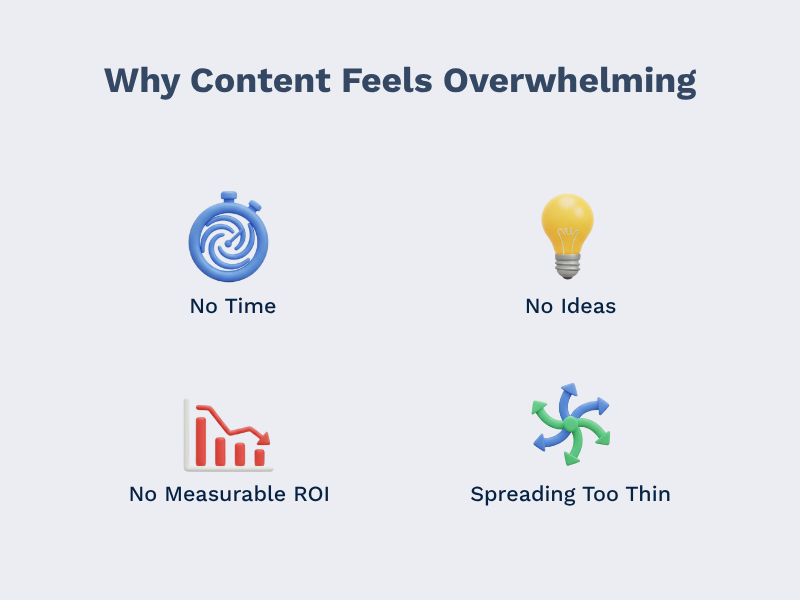You’ve set up your blog, posted a few times on social media and even tried launching a newsletter. But after weeks, maybe months, the results still feel underwhelming. Little engagement, unclear outcomes and mounting pressure to keep up with content for the sake of consistency.
This is a familiar story for many small and medium-sized businesses. With limited time, small teams and no dedicated content specialists, even well-intentioned content efforts can quickly feel overwhelming or ineffective.
But content marketing doesn’t have to be complicated. With the right content strategies, SMEs can move from scattered posts and last-minute scrambling to a focused, streamlined plan that drives results.
Studies show that nearly 70% of small businesses struggle to keep up with content marketing due to time and resource constraints and only 28% have a documented strategy. But, the SMEs that focus on just one or two content channels and repurpose their content see up to 50% more engagement and three times the ROI-proving that a simple, focused approach works best.
In this blog, we’ll explore the common reasons why content feels unmanageable for SMEs and share practical ways of simplifying content creation while improving content ROI, with no massive team or budget required.

For many SMEs, content marketing often feels like another task on an already packed to-do list. One of the biggest hurdles is the lack of time and resources. With small teams juggling multiple roles, finding the bandwidth to consistently produce quality content becomes nearly impossible. Content gets pushed to the bottom of the priority list or rushed out without a clear goal.
Even when time is available, there’s often a struggle to generate ideas. Without a clear understanding of what the audience wants to hear, many businesses either default to overly generic topics or suffer from creative paralysis. This leads to sporadic posting and content that doesn’t connect.
Another common issue is the difficulty in measuring ROI. Many SMEs post blogs or videos without a clear system for tracking performance. Without data to show what’s working, it becomes hard to justify the effort and the value of content marketing gets questioned.
Finally, there's the mistake of trying to do too much. To cover all bases, some SMEs spread themselves thin across too many platforms, from LinkedIn and Instagram to YouTube, blogs and email, without a defined strategy or plan. The result is scattered content that lacks cohesion and consistency, which makes it harder to build momentum or see results.
These challenges can make content feel more like a burden than a growth tool, but with the right structure and systems, it doesn’t have to be that way.

The key to effective content marketing isn’t working harder; it’s working smarter. For SMEs, this means focusing on efficiency and sustainability rather than chasing constant output. By streamlining your process, you can create consistent, quality content without burning out your team.
A great place to start is by repurposing high-performing content. If a blog post gained good traction, you can break it down into bite-sized tips for social media, expand it into an email series or even turn it into a short video or infographic. This approach helps you get more mileage from your best ideas while keeping the workload manageable.
Next, implement a content calendar. Planning your topics reduces the stress of last-minute content creation and allows you to align your efforts with campaigns, events or seasonal trends. It also helps ensure your messaging is consistent across platforms.
Using the right tools can make a huge difference. Tools like ChatGPT for writing support, Canva for design and Grammarly for quick proofreading are ideal for simplifying content creation, especially when resources are limited. They can speed up production while maintaining quality.
Lastly, prioritise evergreen content, the kind of content that remains relevant over time. Topics like how-tos, beginner guides and frequently asked questions continue to bring value long after they’re published. Focusing on these ensures your time is spent on content that works harder for your business in the long run.
Simplifying doesn’t mean scaling back impact. With a structured, resource-light approach, you can keep content creation consistent, strategic and stress-free.

When it comes to content marketing strategies, many SMEs fall into the trap of thinking that more content equals better results. In reality, it's not about how much you publish, but how well each piece performs. Shifting the focus from quantity to quality is one of the most effective ways to start improving content ROI.
Rather than posting daily for the sake of consistency, aim to publish one high-value piece of content each week. A well-researched blog, a compelling case study or an informative video can generate far more engagement than a series of rushed, generic posts. High-impact content has a longer shelf life, builds authority and is more likely to drive action.
To make sure you’re creating content that performs, rely on data to guide your decisions. Monitor metrics like time on page, click-through rates, conversion paths and social shares. This allows you to double down on what’s working and cut out what isn’t, leading to better outcomes with less wasted effort.
Don’t overlook the value of your existing content library. Instead of constantly starting from scratch, revisit and refresh older posts. Updating a blog with new stats, improved visuals or a stronger call to action can breathe new life into it and keep it ranking well in search.
Speaking of search, make sure SEO is built into your strategy. Optimising your content for search engines helps you attract a steady flow of organic traffic over time. From keyword placement and meta descriptions to link building and structured content, SEO helps you reach more people without ongoing ad spend.
A smarter content strategy is about making every piece work harder, perform better and deliver more value to your audience and your business.

One of the most overlooked parts of building effective content marketing strategies is platform selection. Too often, SMEs feel pressured to be everywhere at once, posting on Facebook, LinkedIn, Instagram, YouTube, TikTok and more. But spreading your efforts too thin rarely leads to results and often leads to burnout.
Instead, focus on one or two primary channels where your audience is already active. For B2B businesses, that might mean concentrating on LinkedIn and email. For e-commerce brands, Instagram and TikTok may be more suitable. This selective focus allows you to tailor your content more effectively and invest your energy where it matters most.
To keep things manageable, consider batching your content creation. Set aside a dedicated time each week or month to produce multiple posts, blog drafts or visuals in one go. This prevents last-minute scrambling and makes content creation feel less like a daily chore.
As your business grows or if time remains a challenge, don't hesitate to delegate or outsource. Hiring a freelance writer, social media manager, or content creator can free up your internal team to focus on strategic tasks. Even part-time support can make a noticeable difference in consistency and output.
Choosing the right platforms, planning and knowing when to seek help are key parts of simplifying content creation and sustaining momentum over time.
Content marketing doesn’t have to be overwhelming. By focusing on simplifying content creation, choosing the right platforms and following a structured plan, you can make content work for your business, even with limited resources.
The most successful SMEs are those that prioritise quality over quantity, rely on data to guide their strategy and make smart use of time-saving tools and processes. With the right content marketing strategies, you can produce better content, spend less time creating it and start improving content ROI in a meaningful way.
Need a simplified content marketing strategy? Let’s create a plan that delivers real results without the overwhelm; contact our team to get the ball rolling.